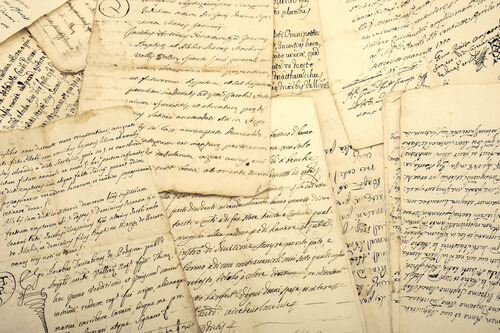
Languages are an important part of human history and culture. They not only show our origins, but also our diversity. There are over 7000 languages worldwide, but which is the oldest language in the world? Many believe that it is the Sumerian language, which is known to have been spoken around 5000 years ago. However, others say that there are even older languages, and in this article we are going to examine the world’s oldest language and take a look at its origins.
Our oldest languages: a journey into humanity’s past
The question of which is the oldest language in the world is both fascinating and complex. Language is one of the most fundamental characteristics that characterise us as human beings. It enables us to communicate, exchange ideas and pass on knowledge from one generation to the next. But which language on Earth was the first to be spoken by early civilisations? This question raises a variety of theories and debates, which we would like to look at in more detail in this blog post.
Insgesamt bleibt die Frage nach der ältesten Sprache der Welt ein Rätsel, das die Linguisten und Linguistinnen weiterhin beschäftigt. Die Entwicklung der menschlichen Sprache ist ein faszinierender Teil unserer Geschichte, der eng mit unserer Fähigkeit zur Kommunikation, zur Kulturübertragung und zur Kooperation verbunden ist. Es ist ein Thema, das die Vielfalt und den Reichtum der menschlichen Kultur und Evolution verdeutlicht.
- The origins of language: The beginnings of human communication is like a mysterious puzzle that is difficult to decipher without written records. However, experts estimate that the languages of prehistoric times date back to at least 50,000 to 100,000 years ago. At this time, our ancestors, the Homo sapiens, were beginning their fascinating journey towards more complex social contexts, utilising the magic of words. In a world full of sounds and noises, they continued to develop their protolanguages, which eventually led to the birth of modern human languages. The primal languages, a masterpiece of human history, served as the foundation for the exchange of ideas, stories and emotions, and became the glue that held our communities together. A truly fascinating origin, for something as precious as words.
- Proto-human languages: The search for the oldest in language leads us to the what is known as ‘proto-human language’. This is a hypothetical precursor language that is used to represent the first languages of mankind. However, there are no written records or concrete evidence of their existence. Instead, linguists rely on comparative linguistics and the reconstruction of languages to draw conclusions about their possible structure.
- The role of hunter-gatherers: In the early days of human history, our ancestors lived as hunter-gatherers. The need for coordination when hunting and gathering food could have contributed to the emergence and development of language. Communication when planning hunting expeditions or sharing experiences and knowledge about certain plants and animals was crucial for survival.
- The abundance of languages: Over the course of time, countless different languages have emerged from the original languages of mankind, due to migratory movements and geographical isolation. Today, over 7000 languages exist worldwide. This long list of languages shows impressively how language families have developed over thousands of years.
- The difficulty of reconstruction: Reconstructing the oldest languages in the world is extremely difficult and speculative, as there is no direct evidence. Linguists use comparative linguistics to identify common features and similarities between languages and draw conclusions about their common ancestors. Nevertheless, this remains a controversial and debated topic.
Overall, the question of the development of the oldest languages in the world remains a puzzle that continues to occupy linguists. The development of human language is a fascinating part of our history that is closely linked to our ability to communicate, transmit culture and co-operate. It is a topic that illustrates the diversity and richness of human culture and evolution.



The 10 oldest known languages in the world
Our 10 oldest known languages in the world showcase a fascinating blend of ancient languages that have evolved into the modern languages that we use today.
- Sanskrit: Known as one of the oldest languages in the world, Sanskrit is a language that was spoken in ancient India and serves as the foundation for many modern Indian languages. It remains a sacred language in Hindu rituals and classical literature.
- Egyptian: The Egyptian language, famous for its hieroglyphics, was spoken in ancient Egypt and thrived for several millennia as a sacred language of rituals and governance.
- Akkadian: As the language of ancient Mesopotamia, Akkadian was written in cuneiform on clay tablets and influenced many later Semitic languages, playing a crucial role in the region’s historical narrative.
- Hebrew: Originally spoken by the ancient Hebrews, Hebrew is now a modern language and the liturgical language of Judaism. Modern Hebrew is a thriving language in Israel today.
- Chinese: The Chinese language is one of the oldest and most widely spoken languages in the world. Its script has remained relatively unchanged for thousands of years, making it a cornerstone of East Asian culture.
- Greek: With a long tradition, the Greek language has laid the foundation for many modern European languages. Modern Greek has evolved from its ancient counterpart, which heavily influenced Western culture through classical literature and philosophy.
- Latin: Spoken in ancient Rome, Latin is the precursor to the Romance languages, including Spanish, Italian, and French. Today, it serves primarily for scientific terminology and the Catholic Church.
- Arabic: With a rich history, the Arabic language is the sacred language of Islam and has profoundly impacted science, mathematics, and literature. It continues to be one of the most widely spoken languages globally.
- Tamil: As a Dravidian language spoken in South India and Sri Lanka, Tamil boasts an ancient literary tradition and is spoken by millions of people today, bridging ancient language roots with modern usage.
- Tibetan: Spoken in the Himalayan mountains, Tibetan has an ancient written tradition closely associated with Buddhist texts, reflecting its role as both a sacred and cultural language.
Which of the oldest languages are still spoken?
It is difficult to determine whether any of the oldest languages are still spoken, as these languages have a long history and have changed over time. Some of the oldest languages still spoken are:
1. Tamil: This has been spoken for over 2000 years and is one of the oldest existing Dravidian languages.
2. Hebrew: This was never completely lost and is the official language of Israel today.
3. Chinese: The Chinese language, with its earliest written records dating back to the Shang dynasty (around 1250 BCE), boasts a rich linguistic history and diversity that includes several dialects like Mandarin and Cantonese. It is the most widely spoken language in the world today, reflecting its global influence.
4. Greek: This has been spoken for over 3000 years and has a rich literary tradition.
5. Aramaic: a language of the Semitic group, it has been spoken in the Middle East since the 2nd millennium before the turn of time until today. It is a sub-unit of the Semitic languages and was originally spoken in Iraq, Iran, Israel, Lebanon, Syria and Turkey. Despite its original spread and importance, Aramaic is now an endangered language that is spoken by only a few people. It has a special place in the history and culture of the Middle East, and is considered the language of Jesus.
Which are the 5 oldest European languages?
Europe has a rich linguistic diversity, and many of the languages have a long history. Here are the 5 oldest European languages:
1. Basque: spoken for over 2,000 years in parts of Spain and France, Basque is an isolated language with no related languages.
2. Greek: As already mentioned, Greek has a long tradition and has been spoken for over 3,000 years.
3. Hebrew: Although it was only used liturgically for a while, Hebrew language is once more a living language.
4. Latin: This was the language of the Roman Empire and gave rise to the Romance languages. Today it is mainly used in the Catholic Church and to name things in science.
5. Irish: This language has been spoken in Ireland for over 2000 years and has a rich literary tradition.
FAQ – the oldest language in the world
1: What is the oldest known language in the world?
The oldest known written language in the world is Sumerian, which originated in Mesopotamia (in modern-day Iraq) around the 4th millennium BCE. However, it is considered that this human language is much older, but there are no written records from that time.
2: Is there evidence for the existence of oldest spoken languages?
There is no direct evidence for the oldest spoken languages, as they were not recorded in writing in the early history of mankind. Researchers use comparative linguistics to draw conclusions about the origins of language.
3: What role did Neanderthals play in the development of language?
It is thought that Neanderthals had some form of communication, but there is no clear evidence of their language. Modern human language may have developed after our lineage separated from the Neanderthals.
4: How did human language evolve throughout history?
Human language is thought to have evolved from simple sounds and gestures through to complex and diverse languages. The development was driven by social, cultural and technological changes.
5: What are the theories of the origins of language?
There are many different theories on the origin of language, including that of social co-operation, tool use and natural selection. However, none of these theories has been definitively proven.
6: How many languages are there in the world?
There are over 7000 known languages today, but this number is constantly changing as some languages die out while others emerge.
7: Which is the oldest existing language in the world?
The oldest surviving language in the world is difficult to determine, as many ancient languages have been heavily modified over time. Some of the oldest surviving languages are Sanskrit, Chinese and Hebrew.
8: Are there still people today who speak the oldest languages in the world?
Since the oldest spoken languages are not known, it is impossible to say whether people still speak anything like them. Most languages have changed a lot over time and many ancient languages have died out.
9: How can the origins of language be understood?
Researchers use comparative linguistics, archaeological finds and genetic studies to investigate the origins of language. These methods help to formulate hypotheses about the development of human language.
10: Why is the question of the oldest language in the world so difficult to answer?
The difficulty in finding an answer to this question lies in the fact that there is no concrete evidence and the early human languages were not documented in writing. Researchers therefore have to rely on indirect evidence and hypotheses to investigate this question.
Unlock Global Communication: Let Skrivanek Overcome the Language Barriers for Your Business
The rich history and diversity of the world’s languages show how important it is to have expert language services in today’s global business environment. At Skrivanek, we specialize in professional translation and localization to help businesses connect with audiences worldwide. Whether you need translation for sacred texts, modern Hebrew documents, or business materials in a widely spoken language like Chinese, our experienced team is here to help. We can ensure that your message is communicated accurately and respectfully, taking into account the cultural nuances to meet the demands of today’s international market. Let Skrivanek assist you in navigating the complexities of global communication, allowing you to effectively reach new audiences and expand your business.

